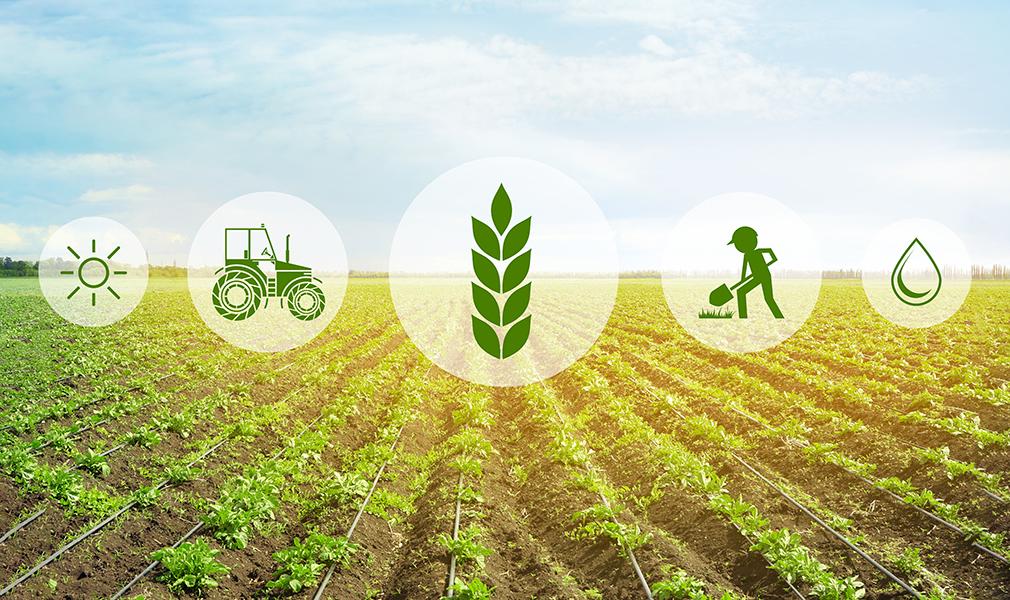Georgia’s Agricultural Sector: Analyzing Indicators and Challenges - Part 2: Government Policy Overview
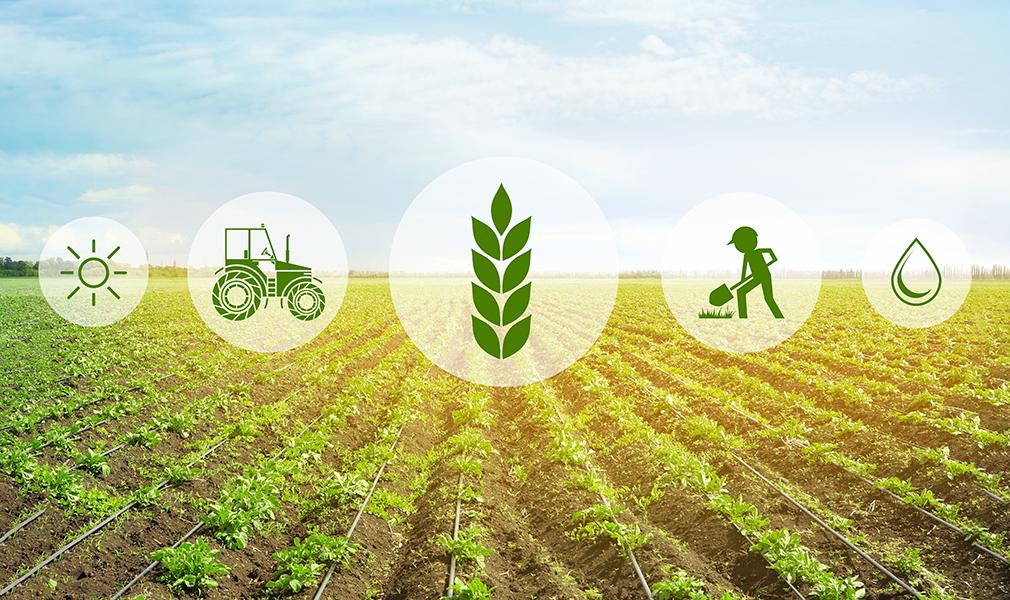
Georgia’s agricultural sector consists of farming crops, animal husbandry and fishery. In 2022, agricultural sector’s contribution to the gross domestic product (GDP) was GEL 4.4 billion which constitutes 6.5% of the GDP. The agricultural sector’s economic growth in 2022 was 2.9% whereas Georgia’s economy increased by 10.1% in the same period. In 2011-2022, agricultural sector’s growth rate was 2.7% which is 1.7 times less as compared to GDP growth rate.
Georgia’s agricultural sector is the largest employer as compared to other sectors and employs over 230,000 people which is nearly 19% of total employment. Average median salary for the agricultural sector’s hired employees in 2021 was GEL 800 whereas average labor remuneration in Georgia was GEL 900.
In terms of efficiency, Georgia’s agricultural sector in 2022 was 3.5 times less efficient as compared to other sectors, because 19% of all employed people in the country – who are employed in the agricultural sector – generated merely 6.5% of the GDP whereas the rest 81% of the employed persons generated other 93.5%.
The major reason behind inefficiency of the agricultural sector is average farm size. As of 2021, some 79.6% of households have less than two-hectares land plots under ownership and 93.6% own farms that are less than two-hectares in size. For comparison, average farm size in the United States of America was 180 hectares in 2021 whereas in Canada it was 327 hectares and in Australia 4,331 hectares. European Union’s average indicator is approximately 15 times larger as compared to Georgia’s 2021 figure and equals 16 hectares. Average farm size in Belgium was 35 hectares, in Croatia 10 hectares, in Ireland 35 hectares and in the Netherlands 27 hectares.
Georgia’s agricultural sector is always one of the top issues among the pledges given by the political parties and therefore, government interferes heavily in this sector. However, before we move to determining the government’s role in the sector it is important to overview the sector and describe the relevant government policy.
Tax and Tariff Policy
Georgia’s agricultural sector enjoys numerous privileges as compared to other sectors. In terms of taxation, agricultural production is one of the least taxed components in the Tax Code of Georgia.
There are six types of taxes in Georgia – income tax, distributed profit tax, value added tax (VAT), import tax, excise tax and property tax.
Tax preferences applied to the agricultural sector are as follows:
- Taxable income earned from the primary supply of agricultural products shall be exempt from taxation if the gross income earned during the calendar year does not exceed GEL 200,000;
- Salary of a person employed in agricultural sector shall be exempt from taxation, if employer’s gross income earned during the calendar year does not exceed GEL 200,000;
- Distributed profit earned from the primary supply of agricultural products produced by agricultural cooperative and expenses shall be exempt from distributed profit tax;
- Primary supply of agricultural products and goods produced in Georgia shall be exempt from the VAT;
- The import of agricultural pesticides and agrochemicals, seeding and planting materials of agricultural crops, according to the list approved by an ordinance of the Government of Georgia shall be exempt from the VAT;
- Physical and legal persons that received agricultural lands to be cultivated shall be exempt from property tax for 5 years.
The abovementioned preferences should give great fiscal incentive to the sector and be a pre-condition of its success. Physical or legal persons involved in agricultural sector pay less amount of taxes as compared to other sectors. In 2022, property tax contribution to the common budget was GEL 603.5 million whereas property tax collected from agricultural land plots was only GEL 27.3 million, amounting to merely 4.5% of total property tax payments. Of GEL 27.3 million, GEL 18.5 million was paid by physical persons and GEL 8.8 million was paid by legal persons.
Apart from direct tax reliefs, the agricultural sector also enjoys indirect tax preferences as well. The Government of Georgia has a protectionist approach vis-à-vis the agricultural products which is manifested in policy to tax import of agricultural products to Georgia by 5% and 12% tax rates whereas export is fully exempt from export tax. As a result of a protectionist policy, Georgia’s population which amounts to 3.7 million people has to pay more for imported products and has to buy food products at higher prices as compared to what they would pay if import tax was removed. Of additional note is that import tax is not a significant contribution of the state budget. Of GEL 14.97 billion tax incomes to the budget in 2022, the share of import tax was GEL 125 million which constitutes merely 0.83% of total tax incomes for the budget.
Spending, Subsidies and Market Regulation
As of 2022, number of employees at the Ministry of Environmental Protection and Agriculture of Georgia was 3,697. Of that amount 1,349 persons (36.5%) worked on agriculture issues. The budget of Ministry was GEL 760.4 million which accounted for 3.8% of total government appropriations and amounted to 1% of the GDP. Over 47% of the expenses were subsidies and budget expenses for agriculture amounted to GEL 669 million.
Diagram 1: Distribution of Expenses of the Ministry of Environmental Protection and Agriculture of Georgia, GEL Million, 2022

Source: Ministry of Finance of Georgia; State Treasury
Diagram 1 shows that after subsidies, other expenses are the largest segment as they encompass current and capital transfers of Unified Agro Project and are not categorized elsewhere. Through the lenses of functional components, GEL 700.5 million was spent in 2022 for agriculture, forestry, fishery and hunting. Of that amount, labor remuneration amounted to GEL 30 million, purchase of goods and services to GEL 79 million, subsidies to GEL 360 million, grants to GEL 25 million and other expenses to GEL 182 million.
For 2023, expenses of the Ministry of Environmental Protection and Agriculture were planned at GEL 698.5 million. Of that amount, expenses for the agricultural sector is GEL 598.1 million whereas the remaining GEL 100.4 million is intended for environmental purposes.
Diagram 2: Structure of Expenses of the Ministry of Environmental Protection and Agriculture Planned for Georgia’s Agricultural Sector in 2023
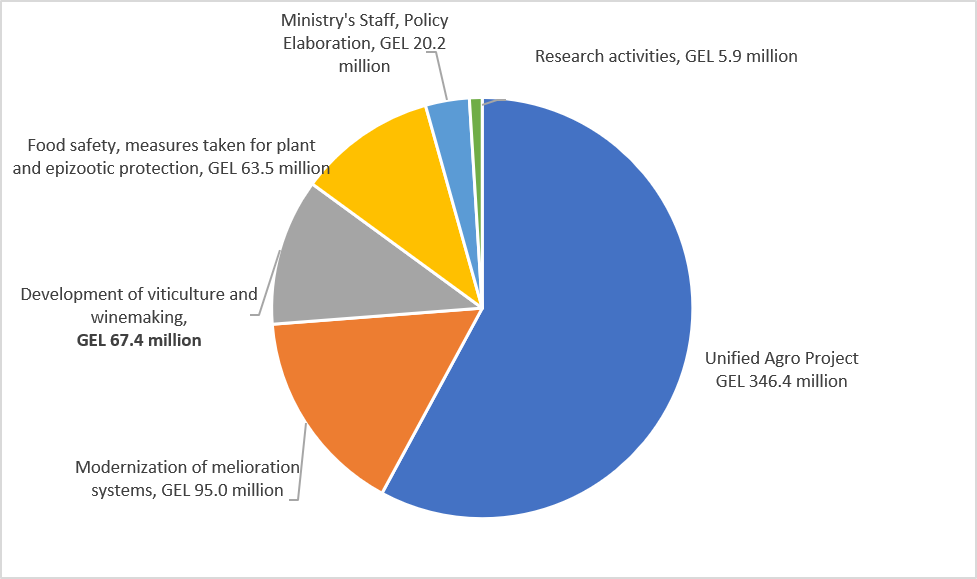
Source: Ministry of Finance of Georgia
Diagram 2 illustrates that Unified Agro Project accounts for most of funds (58%) allocated for the agricultural sector, followed by modernization of melioration systems with GEL 95 million (16%) whereas viticulture and winemaking as well as food safety and plant protection measures are ranked third and fourth with GEL 67.4 million (11%) and GEL 63.5 million (11%), respectively.
Unified Agro Project is run by the Rural Development Agency and is intended to bring together agriculture projects under one umbrella. The project was launched in June 2016. The Unified Agro Project consists of funding of different activities in the agricultural sector and various types of activities are either added or removed from the project.
Graph 1: Unified Agro Project’s Budget in 2015-2023, GEL Million
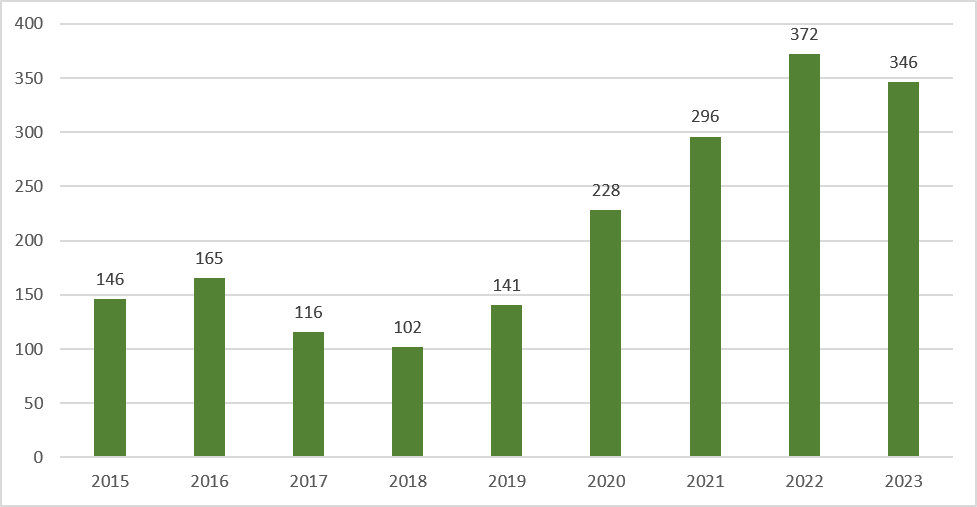
Source: Ministry of Finance of Georgia
The Graph shows that except for 2017, 2018 and 2023 funds allocated for the Unified Agro Project were constantly rising and in 2023 total spending is 2.4 times higher as compared to 2015. In total, GEL 1.9 billion was spent on Unified Agro Project. There were over 25 projects submitted to the Unified Agro Project annually every year and different sums of money were spent each year.
Table 1: Components and Expenses of Unified Agro Project in 2015-2023, GEL Million
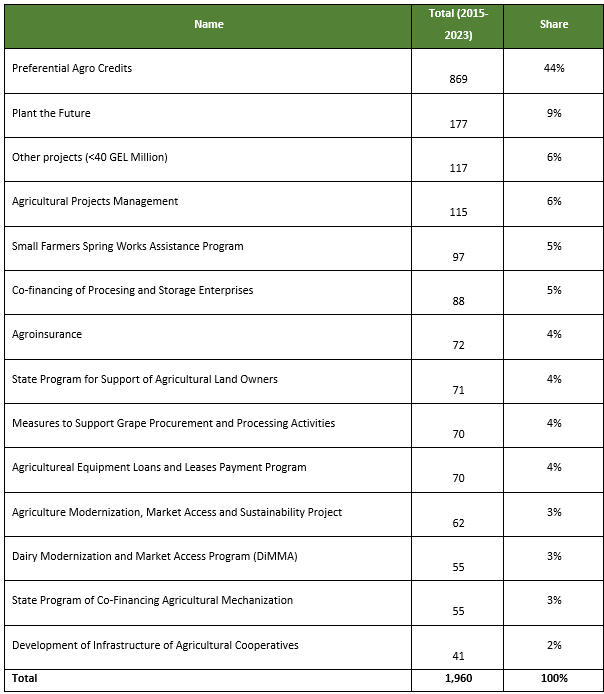
Source: Ministry of Finance of Georgia
The largest component within the Unified Agro Project was Preferential Agro Credit with GEL 869 million which amounted to 44% of total expenses. It is followed by the Plant the Future and Agricultural Project Management (administrative element of the Unified Agro Project) with 9% and 6%, respectively.
The scale of spending gets much larger if we calculate total spending on agricultural sector from the expenses of Ministry of Environmental Protection and Agriculture. In 2015-2023 this figure reached GEL 3.6 billion.
Table 2: Funds Allocated for Agricultural Sector from the Budget of the Ministry of Environmental Protection and Agriculture in 2015-2023, GEL Million
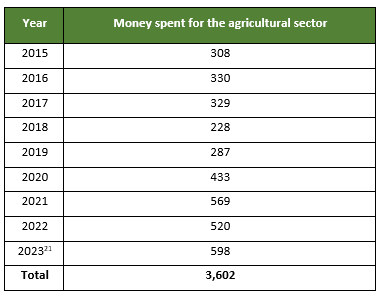
Source: Ministry of Finance of Georgia
Real GDP growth, both in general and sectoral terms, are used to measure efficiency of the government spending.
Graph 2: Real GDP Growth and Agricultural Sector’s Real Economic Growth as Share of the GDP in 2015-2022
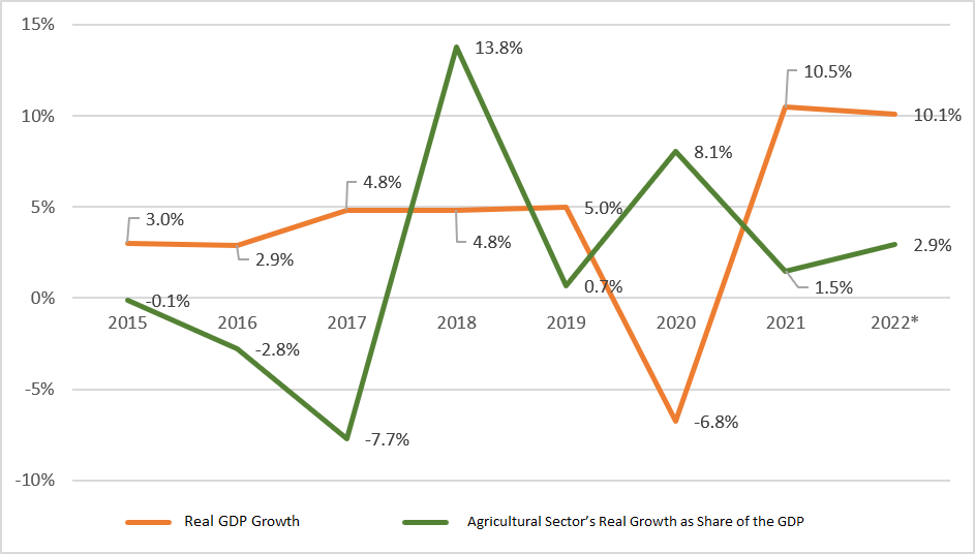
Source: National Statistics Office of Georgia
Graph 2 shows Georgia’s and agricultural sector’s economic growth rates. Although over GEL 1.9 billion was spent on Unified Agro Project alone in 2015-2023 as part of agricultural sector’s funding, agricultural sector’s average growth was only 2% whereas the country’s GDP growth was 2.1 times higher at 4.3%. Given these figures, it is possible to argue that despite spending billions of GEL, agricultural sector has been much inefficient as compared to other sectors and the Government of Georgia’s policy of subsidization may not bring positive results at all.
Together with economic growth rate, number of beneficiaries as well as money spent on beneficiaries are also important criteria when assessing the subsidies. Taking these criteria into consideration, subsidizing agricultural sector is inefficient in most cases. According to 2021-2027 Agriculture and Rural Development Strategy of Georgia and 2021-2023 action plan, number of beneficiaries and spending are as follows:
Table 3: Number of Beneficiaries/Contracts, Total Spending and Spending Per Beneficiary/Contract in 2021

Source: Ministry of Finance of Georgia, Ministry of Environmental Protection and Agriculture of Georgia
Table 3 illustrates that the biggest part of large subsidies in 2021 was channeled to the large beneficiaries. The Agroinsurance was an exception, because the government co-financed payments for 19,748 insurance policies. In case of other large subsidies, most of funds are given to small part of beneficiaries which means that subsidies are allocated for sectoral rather than for social needs. The failure of sectoral targeting is visible on Graph 2.
The agricultural sector enjoys not only tax reliefs, but certain exceptions in terms of regulatory framework. For instance, all individuals who sell personal or domestic household agricultural products or goods produced from that products are exempt from obligation to use receipt printers.
Since 2013, the Parliament of Georgia banned selling agricultural land plots to foreigners. The law is still in effect, although neither before nor after adoption of this law was any research study carried out that would assess efficiency of that regulation. This indicates that there were political and not economic motives behind its adoption. All things being equal, prohibition of selling the land as well as any other product would results in decreased price on it and emergence of black market (in case of land this would be evading the regulation). In addition, this decision is a negative incentive for foreign investors to invest more money in the country, create jobs and additional products, pay more taxes to the state budget, etc. Prohibition of selling and buying agricultural land plots also hinders enlargement of land when average farm size in Georgia is within the margins of 1 or 2 hectares and this indicator is much higher in the developed countries. Therefore, those developed countries enjoy greater degree of competitive advantage as compared to Georgia.
Conclusion
As compared to other sectors, Georgia’s agricultural sector enjoys special tax and regulatory preference from the authorities, but nevertheless remains much unsuccessful than those sectors. In 2015-2023 Georgia’s economy increased by 4.3% whereas agricultural sector’s real growth rate within the GDP was merely 2%.
Agricultural sector is the largest employer as compared to other sectors with 19% of all employed individuals being in this sector. Labor remuneration is low as compared to other sectors and average median salary is GEL 800. The major source of inefficiency is that average farm size is very small and 93.6% of all land-owners own farms that are less than 2 hectares in size. Since the agricultural sector is economically unprofitable and employs over 230,000 people it has been a victim of populist measures of all governments – former and incumbent – which hinders development in a competitive environment.
Georgia’s agricultural sector enjoys almost all tax preferences that are theoretically possible. Primary production is exempt from the VAT and there are income and profit tax reliefs in place. In addition, the sector has indirect preferences. In particular, Georgia has an import tax which is mostly applied to import of agricultural products. This puts the Georgian farmers in an advantageous position vis-à-vis the importers on the one hand and on the other hand it harms economic incentives and hinders development of market in a competitive environment.
On top of tax reliefs, the government spent over GEL 3.6 billion in 2015-2023 in the agricultural sector. One of the largest subsidizing program is Unified Agro project which accounts for more than 54% of total spending in the sector – GEL 1.96 billion. Unified Agro Project subsidizes Preferential Agro Credit, nursery and garden household, insurance of land plots, production of Georgian tea and tangerine as well as processing projects and other activities that are supposed to positively affect development of the agricultural sector. Despite this, average annual real growth rate of the agricultural sector in 2015-2022 was only 2%.
Under market economy, selecting agricultural or any other sector and directing efforts to improve its success indicators should not be the government’s job. If any particular sector’s positive economic indicators are the government’s aim, the best solution will be creation of competitive environment without stimulation, subsidies and tax reliefs. That is why it is key to revise government policy and approaches based on costs incurred and benefits reaped in the previous years.
Appendix
Table 4: Property Tax Rates on Arable Land (including land under perennial crops) and Homestead Land:

Source: Georgia’s Legislative Herald, Tax Code of Georgia
Table 5: Property Tax Rates for Grassland and Pastureland:
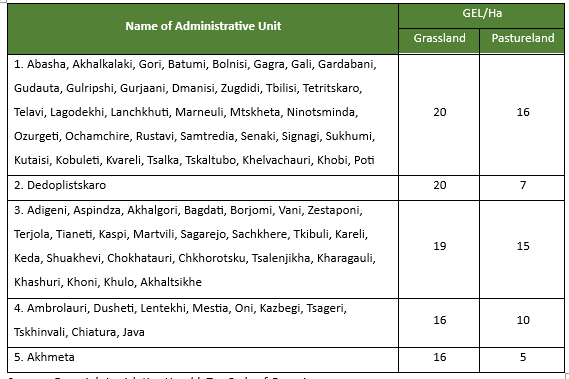
Source: Georgia’s Legislative Herald, Tax Code of Georgia
Table 6: Unified Agro Project Components for 2015-2023
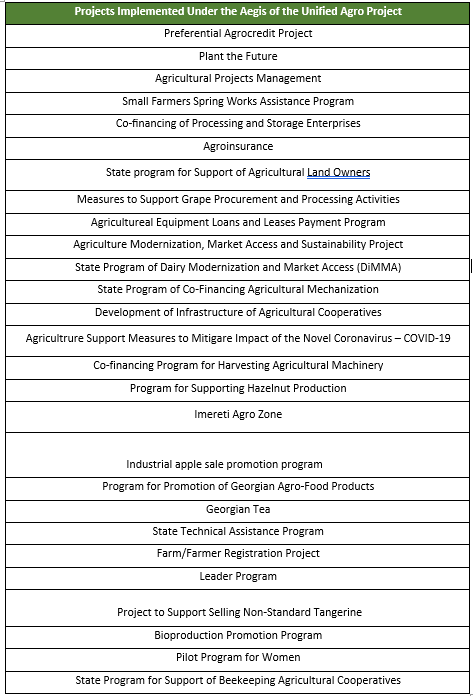
Source: Ministry of Finance of Georgia
See the attached file for the entire document with relevant sources, links and explanations.


